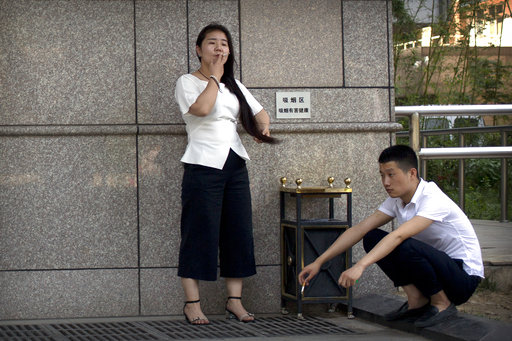Beijing declares war on smoking
China is the world's largest producer and consumers of tobacco, with 300 million smokers and over a million deaths per year. Dozens of provincial divisions have already tightened regulations, and the “Healthy China 2030” plan aims to reduce adult smokers to 20%. For months, Shanghai has been experimenting with bans even in outdoor sensitive areas. Meanwhile, civic activism is growing, and students are also pushing for smoke-free campuses.
In China, it is open warfare against smoking. This is a very serious problem for a country considered the largest producer and consumer of tobacco in the world, with over 300 million smokers and more than one million people dying each year from smoking-related diseases.
In the first half of last year, 24 provincial divisions had already introduced local regulations to combat tobacco consumption. Meanwhile, the national “Healthy China 2030” initiative, which aims to reduce the percentage of smokers aged 15 and over to 20% by 2030, has been in place for some time.
The city of Shanghai was a pioneer in tobacco control in China, being the first to ban smoking in indoor public places in 2010. Since then, anyone caught lighting a cigarette in places such as schools, hospitals, public transport and restaurants will first receive a warning and then a fine of 50 to 200 yuan (approximately £6 to £24) if they resist.
In an effort to further reduce tobacco addiction, in March this year, the city launched a pilot programme to combat smoking in outdoor public spaces as well. According to guidelines published by local authorities, tourist sites, schools, restaurants and bars throughout the city are required to post no-smoking signs in waiting areas and train staff to discourage smoking. Citizens can report violations by calling a government hotline. Individual offenders face fines of up to 200 yuan (approximately £24), while establishments can be fined up to 30,000 yuan (approximately £3,600).
The initiative appears to have been very well received by residents. Responding to a survey conducted by the city's health regulators, over 90% of respondents admitted that they did not tolerate being constantly exposed to second-hand smoke while walking down the street.
Among them is Zhang Yu, a financial employee by profession and fervent anti-smoking influencer. Several videos posted on Chinese social media show Zhang politely but firmly confronting those who violate the smoking ban in shopping centres, apartment buildings, hospitals and other public spaces in Shanghai, urging them to ‘put out their cigarettes or leave’.
‘Smoking is a very personal matter, but when it harms others, it becomes a really bad thing,’ he told Sixth Tone. He added that most of his interventions are resolved without major problems and that only in rare cases, when faced with stubborn smokers, has he been forced to call the police.
Support for Zhang on social media is almost unanimous, with many saying they have started to follow his example and encouraging him to ‘keep it up.’ Among the ranks of anti-smoking advocates is Xu Lihong, a 26-year-old healthcare worker from Chengdu with over 5,600 followers on Xiaohongshu.
“We are not asking smokers to quit for good, but we believe that the freedom to smoke should not come at the expense of others” right to avoid second-hand smoke,“ said Xu, proclaiming herself 'ambassador for tobacco control”.
To make anti-smoking measures in her city more effective, the activist suggests clearly distinguishing between areas where smoking is permitted and those where it is not. She has noticed that when no-smoking signs are clearly visible, people are much more likely to comply with her requests.
According to Xu, the penalties for those who violate the law are too lenient and therefore ineffective. Despite the difficulties, the young woman is steadfast in her commitment and has built a network with other anti-smoking activists to share experiences and offer support. ‘I hope for a future where all public spaces are free from second-hand smoke,’ she said.
Zhang Ruicong, a university student from Zhejiang province, said she was verbally abused after asking someone to stop smoking on an escalator at a railway station. She also saw several men in a restaurant who continued to smoke next to children, despite repeated requests to stop. ‘Many people consider smoking to be normal or are afraid of causing problems by talking about it,’ she said, highlighting the deep-rooted social attitudes in China towards this habit. She added that even her mother considers her position to be ‘extreme’.
Despite everything, the young woman remains optimistic. She believes that the younger generation is leading the change on this issue and, citing her university's “smoke-free campus” campaign, she reiterated her belief that “students are catalysts for social progress”.
The change in attitude towards smoking is also reflected in popular culture. Recently, several comedians have incorporated a kind of “anti-smoking propaganda” into their shows, which has been well received by audiences nationwide.
Particularly indicative is an incident that took place last August in Shaoxing, the birthplace of Lu Xun (1881-1936), one of the leading intellectuals of modern China. A mural depicting the famous writer smoking, located at the memorial dedicated to him, was at the centre of a heated debate after a visitor complained, concerned about the negative influence the image could have on young people. The man, a certain Mr Sun, did not hesitate to file a complaint via the Zhejiang provincial government platform, believing that the artwork risked making smoking seem appealing to teenagers.
Public opinion was divided between Sun's supporters, who believed that public spaces should avoid images that tend to normalise smoking, and his opponents, who argued that removing or altering the iconic portrait would only be a waste of public resources. Furthermore, for the latter, doing so would have meant distorting history, since at the time of Lu Xun, smoking was not considered a vice, nor was it condemned as a danger to public health. In the end, the second side prevailed: the local cultural authorities decided to preserve the mural, as it was considered part of Lu Xun's historical image.







.png)










